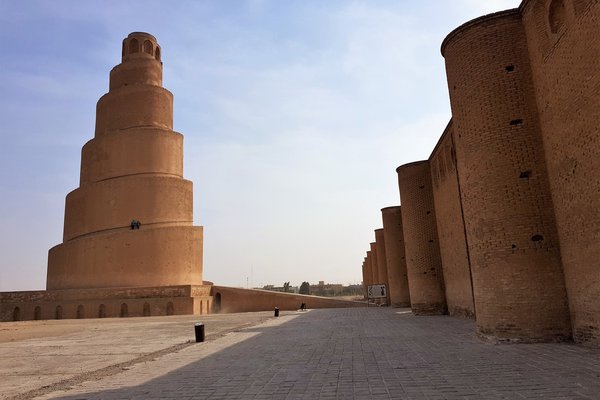Iraq
Samarra
Samarra Archaeological City comprises the remains of a vast and monumental capital of the Abbasid Empire.
The site, although mostly unexcavated, has retained its original city plan. Architectural and artistic innovations developed here spread to other regions of the Islamic world, such as carved stucco and a new type of ceramic. Among its most notable monuments is the 9th-century Great Mosque, featuring a Spiral Minaret.
Community Perspective: the first review was from a visit in 1975, and the second was from one in 2021. Samarra has been virtually inaccessible for many years, but it has come out of the war relatively unscathed. Climbing the spiral staircase is out of the question nowadays, according to Tamas, who visited in 2023. In 2025, Els managed to visit several of the other locations, of which the Abu Dalaf mosque ruins are recommended.
Site Info
Official Information
- Full Name
- Samarra Archaeological City (ID: 276)
- Country
- Iraq
- Status
-
Inscribed 2007
Site history
History of Samarra
- 2007: In Danger
- Needs preventive measures and conservation
- 2007: Inscribed
- Inscribed
- 1983: Deferred
- Deferred until receipt of necessary info
- In Danger
- Needs preventive measures and conservation Since 2007
- Type
- Cultural
- Criteria
- ii
- iii
- iv
Links
- UNESCO
- whc.unesco.org
- Related
-
- archnet.org — Jami' al-Mutawakkil in the Digital Library of ArchNet
All Links
UNESCO.org
- whc.unesco.org — whc.unesco.org/
Related Resources
- archnet.org — Jami' al-Mutawakkil in the Digital Library of ArchNet
News Article
- Feb. 19, 2018 al-monitor.com — Will Great Mosque of Samarra and its minaret survive?
- June 10, 2016 nrttv.com — Students start graffiti clean up of Samarra's spiral minaret
- July 31, 2015 telegraph.co.uk — £500,000 project to save 1,200-year-old mosque threatened by Islamic State
- Nov. 21, 2007 artinfo.com — The construction of a training center and barracks for police is threatening the Great Mosque of Samarra.
Community Information
- Community Category
- Archaeological site: Near Eastern
Travel Information
Red Zone Travel Advisory
All of Iraq except Kurdistan
Recent Connections
-
History of the World in 100 objects
Prog 52 "Harem wall painting fragments"… -
Red Zone Travel Advisory
All of Iraq except Kurdistan
-
Digitized by Iconem
Connections of Samarra
- Individual People
-
-
Gertrude Bell
Photo taken April 1909
-
- Geography
-
-
Tigris - Euphrates Basin
east bank of the Tigris River
-
- Trivia
-
-
Modelled after
The Terbal of Firuzabad (Sassanid landscape WHS) is thought to have been the architectural predecessor of the Great Mosque of Samarra of Iraq and its distinctive minaret, the malwiya. -
In Video Games
Age of Empires II: Saracens: Great Mosque of Samarra -
On Banknotes
Samarra; 250 Dinars; 2003
-
- History
-
-
Abbasid Caliphate
Its capital from 836-892, several surviving buildings including the spiral minaret -
Located in a Former Capital
Abbasid Caliphate (836-892) -
Silk Roads
(Near) Classic Land Route; in ICOMOS thematic study but no details on role or functionSee en.unesco.org
-
- Architecture
-
-
Octagons
Husn al-Qadisiyya (unfinished city of octagonal shape), Qubbat al-Sulaybiyya (an octagonal building in the middle of which there is a square hall surrounded by an octagonal ambulatory) -
Brick architecture
The Great Mosque and its spiral minaret were built of fired brick and gypsum mortar (AB ev) -
Earth Architecture
"The main building materials are fired brick, mud-brick and adobe" (AB ev)
-
- Damaged
-
-
Damaged in War since WWII
2nd Iraq War "One of the architectural jewels in Samarra is the 52-metre spiral minaret which is part of the Great Mosque of Caliph al-Mutawakkil, built in the ninth century. The minaret, which features on an Iraqi banknote, survived countless invasions and wars, but was badly damaged by insurgent fire in 2005 when American soldiers used it as a lookout post."
-
- World Heritage Process
- Religion and Belief
-
-
Notable mosques
Great Mosque - was the largest mosque in the Islamic World when it was built between 849 and 852, its Spiral Minaret is the most unusual in the Islamic world & the somewhat smaller look-a-like Abu Dulaf Mosque from the same period (both Sunni)
-
- Human Activity
-
-
Hunting Lodge or Castle
"The new al-Malwiya Mosque, built between 849 and 851, formed part of an extension of the city to the east, extending into the old hunting park. Two new palaces with hunting parks were built in the south, at al-Istablât and al-Musharrahat (the Palace of al-Shah)." (AB ev) -
Locations for playing sport
"Three racecourses were built east of the main city. Two have an out-and-back course 80m wide and 10.42km long with a spectators' pavilion at the start and the third a pattern of four circles around a central pavilion (5.3km)." and "Tell Al-Alij is an artificial mound for the caliph to view the horse-races" (Nom File)
-
- Constructions
-
-
Notable minarets
its minaret, the Malwiya Tower, is a vast spiralling cone 52 meters high and 33 meters wide with a spiral ramp (wiki)See en.wikipedia.org
-
- WHS on Other Lists
-
-
Global Heritage Fund
-
World Monuments Watch (past)
Cultural Heritage Sites of Iraq (2008)
-
- Timeline
-
-
Built in the 9th century
Samarra was laid out as a new city in 836 by the Abassid Caliph al-Mu'tasim who wished to create a new court residence and army base outside Baghdad. He died in 847 with the city's mosques and palaces only partly completed but his successor continued with new plans. By 892 a subsequent Caliph returned the capital to Baghdad an, although habitation continued on the site much of the monumental area was abandoned.
-
- Science and Technology
-
-
Archaeological potential
"The city was built in a single layer, 80% of which is unexcavated." (AB ev) -
Digitized by Iconem
-
- Visiting conditions
-
-
Red Zone Travel Advisory
All of Iraq except Kurdistan
-
- Literature & Film
-
-
History of the World in 100 objects
Prog 52 "Harem wall painting fragments" (link)
-
News
- al-monitor.com 02/19/2018
- Will Great Mosque of Samarra and i…
- nrttv.com 06/10/2016
- Students start graffiti clean up o…
- telegraph.co.uk 07/31/2015
- £500,000 project to save 1,200-yea…
Recent Visitors
Visitors of Samarra
- AC
- Afshin Iranpour
- Alexander Barabanov
- Alexander Lehmann
- ALKAREEMNASSER
- A. Mehmet Haksever
- Artur Anuszewski
- Christravelblog
- Clyde
- Cobaltrage
- Els Slots
- Eva Kisgyorgy
- Fan Yibo
- Gernot
- Harry Mitsidis
- henryjiao18
- Loic Pedras
- Maciej Gil
- marcel staron
- Marcobrey
- Martin
- michaelsballard
- Philipp Leu
- Rahelka
- Szucs Tamas
- Thomas Buechler
- Timothy C Easton
- Vsacan
- Wojciech Fedoruk
- Zoë Sheng
Community Reviews
Show full reviews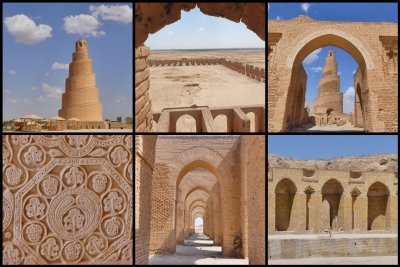
I visited this WHS in September 2024. Samarra lies on the east bank of the Tigris river and it was founded in 836 by the Abbasid caliph al-Mutasim as a new administrative capital and military base. Since the WHS is made up of 10 loosely named locations, it was hard to tell whether I covered all or most of them during a full day exploring Samarra and its surroundings. During the Iraqi Civil War (2006-2008), Samarra was in the "Sunni Triangle" of resistance and even now, the military personnel at checkpoints wear different uniforms and fly different "religious/political" flags.
Ever since the end of Iraqi civil war in 2007, the Shia population of the holy city has increased exponentially and acts of violence and terror are quite common in the area. The city is also home to the al-Askari Shrine, containing the mausolea of the 10th and 11th Shia Imams, as well as the place from where Muhammad al-Mahdi, known as the "Hidden Imam". is believed by the Twelver Shias to have entered a state of occultation. This has made it an important pilgrimage centre for the Imami Shias. For non-Muslims, the mosques of Najaf and Karbala are for more interesting both for their interior as well as their exterior architecture.
The obvious highlights are its two spiral minarets and what remains of their mosques. At the time of its construction, the Great Mosque of Samarra was the world's largest mosque. Its spiral minaret, known as Malwiya (meaning …
Keep reading 0 comments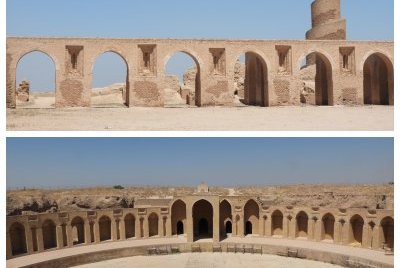
Although best known for its Spiral Minaret, Samarra is much more. It’s the archaeological site of a city that was the short-lived capital of the Abbasids. They built it as a planned city in the countryside, away from the populace of Babylon, to create “a new royal culture revolving around sprawling palatial grounds, public spectacle and a seemingly ceaseless quest for leisurely indulgence". Consider it an early version of one of those new capitals that you also see in Brazil (Brasilia), Indonesia (Nusantara), Myanmar (Naypyidaw). The site is spread across 10 locations in and around the modern city of Samarra, and several of those were visitable in April 2025, although the checkpoint density still is higher here than elsewhere in Iraq.
We started at the Great Mosque. It lies in a particularly ugly patch of the city, almost like an industrial estate. A rope prevented us from coming too close and entering either the mosque or the minaret. The latter, shaped like a Mesopotamian ziggurat, is still picture-perfect. Of the mosque, not much else remains than the outer walls. Both are subject to a restoration project (the official reason given for not being allowed to enter), but no work seemed to be ongoing.
When you go out of the city and cross into the desert, the remains of the Abbasid city walls can still be seen clearly. We drove on for some 15km to the Abu Dalaf mosque. I enjoyed it tremendously from the start: its …
Keep reading 0 comments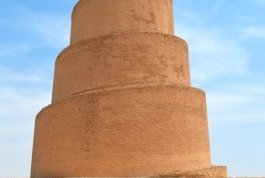
In theory Samarra could be a very interesting site. This is the only islamic site of Iraq, so its imporatance in Iraqi culture in unquestionable. . Samarra was the capital of the Abbasid caliphate from 836 CE, when Caliph Al-Mu'tasim founded a new capital at the banks of the Tigris, till 892, when al-Mu'tadid returned the capital to Baghdad. The period between these dates was one of the most dramatic, turbulent half century in the history of the caliphate. Majestic buildings were erected and events that are crucial in the formation modern Iraq (and the Shi'ite world) happened here. (The death of the 12th and the occultation of the 13th imam.) On the other hand Samarra is not far from Baghdad, an easy day trip on the northern motorway. This is the theory.
The reality is, that Samarra is even now not the most welcoming city in Iraq. The population is predominantly Sunni, but the law enforcement is provided by a Sadrist Shi'ite militia (Saraya al-Salam - their emblem, the peace dove is ubiquitous on grafitties in the city). There are no such restrictions now, that Wojciech described, tourists can enter the area after identity check, without leaving the passports with the militiamen, but - unlike in Baghdad or other major cities - you can still feel the tension in the air. The most illustrious - and best kept up - building in the city, the al-Askeri moque is not part of the World Heritage Site - understandably by …
Keep reading 0 comments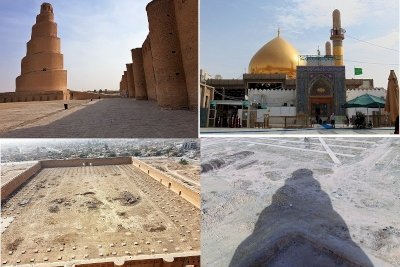
Samarra is a true symbol of Iraq. The spiral minaret of the Great Mosque is perhaps the most famous monument in this country, more famous than the monuments of Babylon. Although Samarra is quite close to Baghdad, it has been virtually inaccessible for many years. The reason was primarily security concerns - Samarra is an extremely important place for Shi'ite Islam. Even now, in November 2021, Samarra is under special protection - when entering, at the checkpoint on the main road, we had to leave our passports and pick them up on the way back.
Samarra's UNESCO inscription contains many places, but there is no doubt that its focal point is the ruins of the 1,200-year-old Grand Mosque (once the largest in the world), which includes a wonderfully reconstructed spiral minaret. You can climb this minaret and admire the ruins of the Grand Mosque from above, just be careful not to fly down - there are no barriers (the top of the minaret has been destroyed), and the wind blows very hard! There is an entrance fee of IQD 25,000 (~USD 17) but it is worth paying - the site is quite well preserved. You can even buy a souvenir - a small replica of the spiral minaret.
Samarra was taken by the Islamic State, but for a very short time and these barbarians did not manage to seriously destroy anything - Shi'ite mosques were practically intact. In Samarra, we also visited another monument that cannot be missed …
Keep reading 0 comments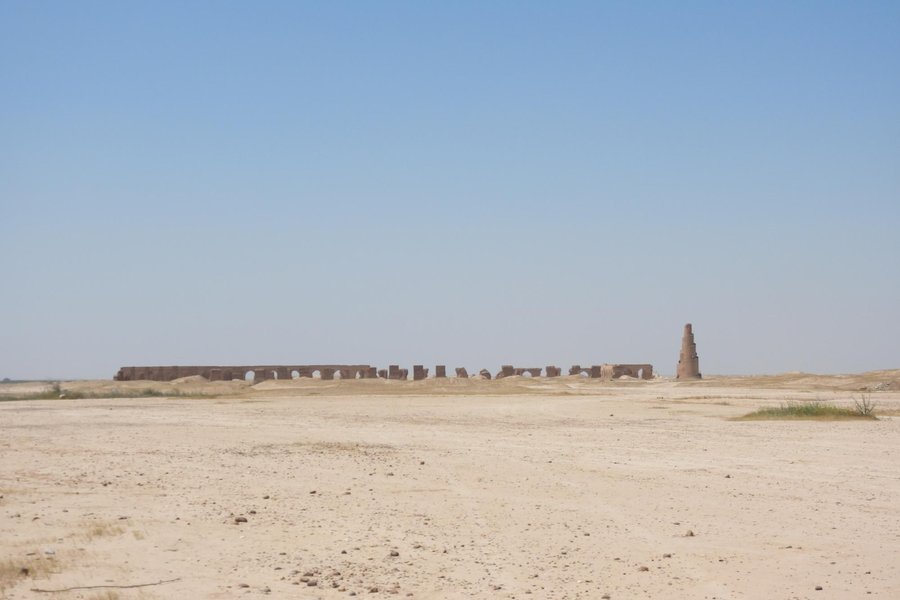
In 1975 we visited Samarra and we were astounded by the spiral minaret which stand out prominently in the desert surroundings. Climbing on the spiral outside staircase, was interesting and our guide said, the higher you climb, the luckier you get! The mosque nearby was admirable, so my Italian husband said and the view from the top was breathtaking, as the ruins from afar were clearly seen
A great experience.
Keep reading 0 comments
